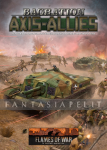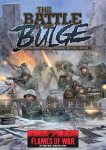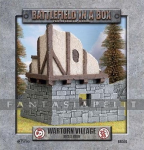Gung-Ho -US Marine Corps in the Pacific

Gung-Ho and Banzai mark our first step into the Pacific Theatre of Operations (PTO) since the first release of Flames Of War in 2002. Some long-time players will no doubt be thinking, âAbout time!â
The new books mark a change in format, concentrating on one nation rather than offering two opposing nations. With this format we are able to offer more intelligence briefings, options, and background in two 48-page books than we could in a single 72-page book.
USMC has had a long and proud history as part of the US Armed Forces, and the Pacific Campaign of 1941 to 1945 is perhaps its finest hour. During the course of the war the Marine Corps had expanded from two brigades of about 18,000 Marines to six divisions, five air wings, and various supporting arms to over 485,000 Marines.
* Amphibious assaults!
* Fearless veteran troops!
* F4U Corsair air support!
* Naval air & sea support special rules!
49-pages, soft bound
The US Marine Corps has had a long and proud history as part of the US armed forces, and the Pacific Campaign of 1941 to 1945 is perhaps its finest hour.
During the course of the war the Marine Corps had expanded from two brigades of about 18,000 Marines to six divisions, five air wings, and various supporting arms to over 485,000 Marines.
They were the tip of the American spear during the Pacific campaign conducting amphibious assaults from Guadalcanal in the Solomon Islands, through the atolls of Marshall Islands, to Islands of the Marianas with the invasions of Saipan, Tinian, and Guam. They prepared the way for the assault on Japanese by taking the Japanese possessions of Iwo Jima and Okinawa, facing fierce fanatical resistance from Japanese defenders in some of the most savage fighting of the entire war.
The first Pacific book covers the US Marine Corps. The land and sea fighting troops of the US Naval Department, though not part of the US Navy, were closely associated with them. They were at the forefront of much of the fighting in the Pacific, bearing the brunt of many of the Japanese attacks early in the war, but eventually leading the fight during the liberation of the Pacific Islands from the clutches of Imperial Japan.
So what will you find in Gung-Ho? We cover the Marine Corps role in the Pacific War, look at their methods and tactics and take a closer look at two of their campaigns, Saipan and Okinawa, both with gaming and scenario suggestions.
Gung-Ho also includes rules and two missions for performing Amphibious Assaults, Island Landing and Atoll Landing. The Island Landing Mission has your Marines landing on an Island without a coral reef or a lagoon, where the landing craft and amphibious vehicles come straight onto the beach. In the Atoll Landing Mission the Marines must negotiate a coral reef, then a shallow lagoon, before they hit the beach. The Amphibious Assault rules include rules for the reef, lagoon, and for getting your troops ashore, be they in Landing Craft, Amphibious LVT(4) Amtrac or DUKW trucks.
Special Rules
The US Marine Corps, as befits a corps with proud traditions, has its own special rules. The Marines use the US special rules on pages 236 to 240 of the Flames Of War rulebook, plus they have the Gung-Ho, Semper Fi, BAR Automatic Rifles and War Dogs rules.
'Gung-ho' is a Chinese term appropriated by Major Evans Carlson to apply to the Marines of his 2nd Raider Battalion. In Chinese, 'gung-ho' means working together, working in harmony. Carlson wanted his Marines to mirror this ethic. The term was popularised by the 1943 film âGung Ho!â about the 2nd Raider Battalionâs raid on Makin Island in 1942.
Special Rules
'Gung-ho' conveys the Marinesâ willingness to tackle any task and their commitment to the Corps. The Gung-Ho rule gives Marine Platoons the German Mission Tactics special rule, allowing another team in the platoon to take on the role of command team if the previous command team is destroyed.
Semper Fi
'Semper fidelis' (often shortened to Semper fi) is the motto of the United States Marine Corps. It is a Latin phrase that means âalways faithfulâ or âalways loyalâ. The Semper Fi rule allows Marine platoons to re-roll Motivation tests to counter-attack in Assaults.
BAR Automatic Rifles
In 1944 the Marines increased the firepower available to their platoons by equipping each squad with three BARs (Browning Automatic Rifles). These formed the basis for each fire team. The BAR Automatic Rifles rule means that BAR teams retain their full ROF when moving, but gain a +1 To Hit penalty. They also re-roll failed To Hit dice in Assault defensive fire when Pinned Down.
War Dogs
The final special rule covers the Marineâs use of war dogs for reconnaissance. Because of a dogâs powerful senses, Dog handler teams force Ambushing teams to be at least 10â/25cm away from them if Ambushing from concealment.
Forces
The book, of course, includes three Intelligence Briefings for US Marine Forces in the Pacific. These are a Marine Rifle Company, a Marine Tank Company, and a Marine Amphibian Tank Company. Most Marine platoons are rated Fearless Veteran. The Marine Rifle Company centres around the Marine rifleman, which can be either Rifle teams, or for the later organisation, BAR teams. The Marine Rifle Platoon can also be mounted in LVT(4) Amtrac amphibious armoured carriers.
Gung-Ho: US Marine Corps in the Pacific
As well as up to three Marine Rifle Platoons, combat platoons also include a Company Machine-gun Platoon with M1919 LMG teams, and a 60mm Mortar Platoon with three M2 60mm mortars. Both of these platoons can combat attach teams to the Marine Rifle Platoons.
Weapons platoons add further supporting machine-guns and mortars, this time in the form of M1917 HMGs or M1 81mm mortars. The Machine-gun Platoon can instead take M2 .50 cal HMGs. The Assault Section provides the Marine Rifle Platoons with additional weapons for beach and bunker assaults with Bazooka, Pioneer Rifle and Flame-thrower teams.
The Regiment provides heavier weapons to support the Marines with 37mm anti-tank guns, scouts, and self-propelled guns (75mm M3 or 105mm M7). The 37mm M3A1 guns also fire Canister rounds that give it ROF 4, anti-tank 1, and firepower 6, ideal for cutting down an aggressive Japanese assault.
The Marine Tank Company and Marine Amphibian Tank Company use the same company diagram, but each has its own HQ and Combat Platoons column. The Marine Tank Company focuses on the Sherman tanks that support the Marines operations in 1944 and 1945. These can be either M4A2 or M4A3 (late) Sherman tanks. The M4A3 (late) tanks have more powerful engines and more armour (Front 7). Under Pacific points the Sherman is expensive, so if you are using this option you only need to take one Combat Platoon. In addition the minimum number of tanks required is also lower in the platoons for the Pacific points option. The Marine Amphibian Tank Company is based around the Amtanks (Amphibian Tanks). These can be either the LVT(A)4 (75mm) armed with a short 75mm howitzer in a similar turret to the M8 Scott, or the LVT(A)1 (37mm) with a 37mm gun in a Stuart like turret. The role of the Amtanks was to lead the amphibious assault ashore and offer immediate support until the Sherman tanks could be brought ashore. These tanks are lightly armoured (Front 1, Side 1), but well-armed with machine-guns as well as their main guns.
US Marine Corps Support
The support section of the book includes light tanks, flame-tanks, reconnaissance, war dogs, engineers, artillery, rockets, anti-aircraft, air support, naval gunfire, naval air & sea support, and AOPs. The US Army also fought alongside the Marines and their flame-tanks and rifle platoons are available in support.
The Flame-tank was an important weapon in the Pacific where stubborn Japanese troops often proved hard to clear from bunkers and underground complexes. Initially the Marines used a Stuart flame-tank known as the Satan, and later fitted flame-thrower kits to Shermans as Zippos. These provide the Marines with ideal weapons for clearing out fortifications.
The Marine War Dog Platoon is made up of Dog Handler teams that can be attached to Marine Rifle Platoons and Scout & Observer Platoons to enhance their ability to detect ambushes.
The Marine Engineer Assault Platoon, much like the Assault Section, can be allocated out to Marine Rifle Platoons to enhance their abilities in Assaults with Pioneer Rifle teams and Flame-thrower teams. However, they can also be fielded as a Platoon of their own.
The Marine Rocket Launcher Battery, or âBuck Rogers Menâ, used the 4.5 inch Mk 7 naval rocket mounted in a rack system on the back of a 1-ton truck. Weâve given them the 30 Rockets rule that means each weapon counts as two, or four with extra crew. They also have Speedy Displacement, which allows them to remove their rocket smoke marker if they pass a skill test in the Assault step. Due to the new nature of the Marine rocket arm, they are rated Fearless Trained. Air Support is provided by F4U Corsair aircraft. They come armed with MGs and bombs and can also be additionally armed with rockets and Napalm.
In addition to Naval Gunfire Support, with options for Heavy Cruisers, Light Cruisers, or Destroyers, we have also introduced Naval Air & Sea Support. This represents the battle happening at sea while the fighting on the land takes place. This offers three different levels of support (Carrier Group, Aircraft Carrier, or Destroyer Squadron) that can be used to disrupt your opponentâs Air Support or Naval Gun Fire.
Points
The isolated nature of the Pacific Theatre of Operations and the slow development of weapon technology by the Japanese meant the power and effectiveness of the weapons in the Pacific seem somewhat out of balance with what was being used in Europe at the same time. This led to some weapons, like the Sherman tank, having a greater impact for a longer time than in Europe.
We realised many gamers will also want to pit their Pacific forces against forces from Europe. To cover this you will find two point levels for each platoon, one for the Pacific War, intended for playing games within the context of the Pacific Theatre, and Late-war, with points compatible with any other Flames Of War forces with Late-war points.
Pacific War Points are also compatible with Early-war Points, although not all the equipment was available in the Early-war (1939-1941). Whatever points option you select, you and your opponentâs forces must be entirely selected from that points option.
viivakoodi 9780994120632
summittainen saatavuus liikkeissä
Helsinki (myymÀlÀsaldoa ei ole saatavilla erikseen)
liike&varasto: +
Joensuu: -
Jyväskylä: -
Kuopio: -
Oulu: -
Tampere: -
Turku: -
Tuotteen kanssa aiemmin tilattua
|
LIIKKEET
|
TILAAMISESTA |
|
INFO |













